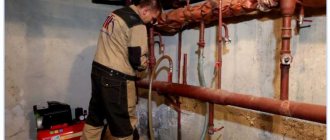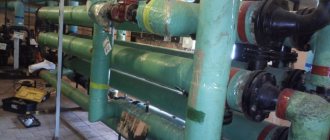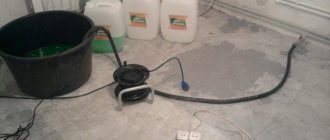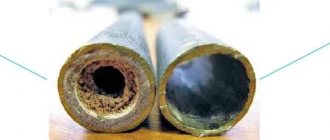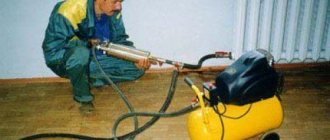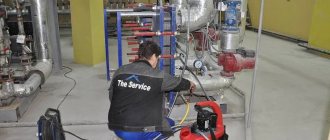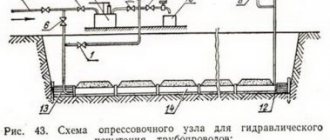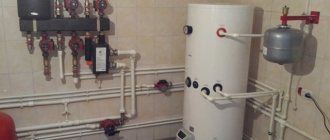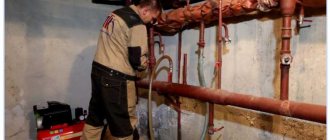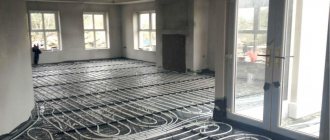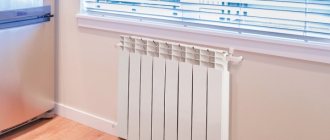In order for the heating system to maintain its efficiency and performance for as long as possible, it must be flushed periodically. This simple event allows you to remove scale and various types of debris from the system elements.
Flushing and pressure testing of the heating system
According to the rules, flushing the heating system must be carried out by specially trained people. But if you wish, you can do this yourself. Read the provided guide and get started.
Flushing and pressure testing of the heating system
Why flush your heating system?
Have you noticed that some of your friends or neighbors have much warmer radiators than yours at home? There may be several reasons for this, but the most common is the presence of blockages in the heating lines. It is to eliminate such troubles and prevent their further occurrence that flushing is performed.
Symptoms and manifestations of a clogged heating system in a private home
Heating efficiency is reduced due to two main factors, namely:
- the appearance of mineral deposits in pipes. Most often, this problem is observed in systems equipped with non-galvanized steel pipes. Calcium and magnesium salts begin to deposit on the pipe surfaces, which leads to a significant reduction in throughput. In systems built using galvanized pipes, this problem usually does not arise;
The appearance of mineral deposits in pipes - silting of heating radiators. Most often, areas where the coolant moves at low speed become silted.
Radiator silting
Cast iron batteries, as well as radiators with a large number of sections, are most susceptible to silting. The relationship is simple: the more sections and the larger they are, the slower the coolant moves through the system and the higher the likelihood of silting.
Signs of air locks
The first sign of air in the system is poor heating of the batteries. The battery warms up unevenly, not enough, and if any sounds appear in it, then the answer is clear - the air in the heating radiators is preventing the circuit from working properly. If the radiators have a bottom connection, and its upper part is cold, then air has accumulated in such a radiator and bleeding the air from the heating radiator will restore normal operation.
Removing air from heating circuits
There is a lot written on the Internet about what needs to be done and how to remove air from a heating battery. For open heating systems with an expansion tank, this problem is not relevant. In such systems, the air exits independently through a tank located at the highest point of the circuit. Problems with some radiators may arise, especially if the slope is chosen incorrectly. Such air bubbles are removed using Mayevsky taps or automatic air vents.
For closed systems with forced circulation, the problem of how to get rid of air in the heating system is also completely solvable. Air is removed from the batteries manually by opening the Mayevsky tap. If you hear a hissing sound when you open it, then the actions are correct and there is air in the system. The air must be released until water appears at the outlet of the Mayevsky tap.
Such accumulations of air can completely stop the circulation of water in the system. If the installation of problematic areas of the circuit, for some reason, cannot be changed, then a heating system air bleed valve is installed in such problematic areas to bleed it.
Features of aluminum radiators
An unpleasant phenomenon is sometimes observed in aluminum radiators. The radiator material reacts with water. As a result, gases are constantly formed and must be constantly removed from the radiator, and how to remove air from a heating battery is described above. To avoid the problem described above, it is enough to buy and install aluminum radiators with an internal anti-corrosion coating. The correct solution would be to replace the aluminum radiator with a bimetallic one.
Instructions for flushing the heating system
Pneumatic pulse cleaning scheme
There are 2 main methods for flushing the heating system, namely:
- using special hydropneumatic equipment;
- using chemical reagents.
Prices for popular models of air compressors
Air compressors
Flushing using the hydropneumatic method
Hydropneumatic flushing of heating systems - instructions
Hydropneumatic flushing of heating systems - instructions
This method is actively used by domestic housing offices and is quite effective. You just need to do everything in accordance with technology.
The principle is extremely simple: first, water is discharged from the system, then it is supplied back. A special pneumatic pump is used to “adjust” the water flow. As a result, under the influence of a fairly powerful pressure, scale and other deposits peel off, and when the water is drained, they are removed from the system.
To carry out this procedure yourself, you will need a pneumatic pump capable of pumping a pressure of more than 6 kg/cm2.
The sequence of actions is as follows.
Before starting work, you must turn off all taps
The end fittings are unscrewed using a wrench
First step. We close the return valve.
Heating system line diagram
Second step. We connect the pneumatic pump to the valve installed after the valve.
Third step. We reset the return line.
Fourth step. Let the pneumatic pump build up pressure above 6 kg/cm2, and then open the valve to which it is connected.
Fifth step. We close off all the risers one by one. We do this so that no more than 10 risers are blocked at one time. Compliance with this rule will make the washing procedure as effective as possible.
Sixth step. We switch the system to reset in the opposite direction. To do this we do the following:
- close the discharge and close the valve connected to the pump, and turn off the device;
- close the open valve, and then open a similar one on the “return”;
- we reset the heating system. To do this, connect the pneumatic pump to the valve in the opposite direction, then open the valve and turn on the pump. The liquid will move in a different direction.
You can determine the required duration of rinsing by eye. Has clear clear liquid started coming out of the system? We can finish! Return the gates and valves to their original positions and turn off the pump.
Prepare a suitable container to collect dirty water. If you wish, you can connect a hose to the battery and ensure that the dirty coolant is discharged into the sewer.
Chemical wash
Scheme of chemical flushing of pipes
This method can be used only in two cases, namely:
- if it is necessary to clean a heating system with natural circulation, built using steel pipes. It is advisable to use chemical reagents in situations where, for any reason, there is no desire to flush the entire system. Most often, blockages are deposited in heat exchangers. The system can silt around the entire perimeter. In the second case, chemical washing will not be of much use;
- if it is necessary to restore the old heating system. Over decades of operation, pipes can become clogged and overgrown so much that the power of the pneumatic pump will not be enough for effective cleaning. It would, of course, be possible to use a more powerful pump, but no one can guarantee that the pipes will not burst under such pressure.
Important! If the pipes are very old, with traces of corrosion and deformation damage, flushing may not have any positive result. Chemical reagents will simply dissolve the rust, causing the pipes to begin to leak. The only effective solution in such a situation would be to replace worn-out lines.
Flushing reagent
The flushing principle is simple: instead of coolant, a special solution containing acid and alkali is poured into the system. Then the mixture is circulated for 2-3 hours (if it is not the natural circulation line that is being cleaned, you will need to connect a pneumatic pump for this), after which it is drained and the pipes are filled with standard coolant.
Reagents for flushing and protecting heating systems
Important! According to the requirements of SNiP, such reagents are prohibited from being discharged into the sewer system. The best option is to neutralize the used mixture using a special composition. You can buy it in the same place where you buy the washing solution.
Never use such chemical mixtures to clean aluminum pipes. If the products remain intact after such washing, they will serve significantly less.
It is recommended to carry out mandatory flushing of the system of a private home at least once every 7 to 10 years.
Test Tools
To test the system for resistance to high pressure, a special device is used, which is called a pressure tester. It is a pump capable of creating pressure inside the system up to 60 or 100 atmospheres, depending on the type of mechanism. There are 2 types of pumps: manual and automatic. They differ only in that the second option stops pumping itself if the pressure reaches the desired level.
The pump consists of a tank into which water is poured and a plunger pump with a handle that moves it. On the body of the mechanism there are taps to block the pressure supply and pressure gauges to regulate the pressure. There is also a tap on the tank that allows you to drain the water that remains in the tank.
The principle of operation of such a pump is similar to a conventional piston analogue, which is used to inflate tires. The main difference is the cylindrical piston made of steel. It is fitted tightly inside the housing and a minimum gap is created, which makes it possible to pump up pressure up to 60 atmospheres.
Manual blowerSource amazon.com
For hand pumps, the biggest disadvantage is that such pressure testing of pipes will take a very long time due to pumping the system with water. This process can take several hours, since large systems that have radiators will need to be filled manually.
Automatic devices work on a similar principle, but when the pressure limit is reached, they turn off themselves. They also require electricity to operate, so manual ones are more suitable for places where there is no power supply yet. Automatic pumps can pump pressure up to 100 bar, and industrial devices up to 1000 bar.
Electric version of the compressor Source ngenix.net
Is it possible to wash a separate battery?
Now you know how to flush the heating system. However, sometimes it becomes necessary to clean a separate battery. There is a solution for this situation too.
Heating battery cleaning scheme
Important! Flushing a separate heating radiator must be done strictly before the start of the heating season.
Buy a flushing faucet from a plumbing store. Additionally, you need to purchase a rubber hose and a fitting with a thread that matches the diameter of the purchased flushing valve. Install the fitting onto the hose.
Direct washing is carried out in the following sequence.
First step. We connect the flushing tap to the heating radiator.
Second step. We connect a fitting with a hose to the flushing tap.
Third step. We direct the second end of the rubber hose into the toilet.
Fourth step. Open the flush tap and leave for 20-30 minutes. While waiting, hold the hose so that it does not jump out of the toilet.
Important! Although it is recommended to flush individual batteries strictly before the start of the heating season, in some situations the need for flushing arises when heating is in full swing. If this is your case, insert the hose deeper, directly into the riser. Otherwise, the hot coolant may destroy the toilet.
Video - Flushing a heating radiator
Table for selecting reagents for flushing the heating system
Prices for popular models of heating radiators
Heating radiators
Rules and procedures for carrying out different types of washing
Hydropneumatic flushing technology
The technology for flushing a heating system using the hydropneumatic method involves injecting compressed air into a pipeline filled with water. The resulting air-water mixture moves at high speed, thereby “loosening” and separating existing deposits from the surface of the pipes and removing them beyond the contour.
Hydropneumatic heating flushing using disinfectants
Hydropneumatic flushing is carried out in two ways. The first option involves a flow circuit. First, the system is filled with water - the air collector valve is open, after filling the valve is closed. Then, using a compressor, compressed air is pumped in and the drain pipe is opened. As a result, the resulting water-air mixture passes through all heating devices and then drains. The washing process continues until clean water flows from the nozzle.
The second washing option is carried out using a different algorithm. When the system is filled with water, the air collector valve is closed. Then, compressed air is pumped into the pipeline through the backup pipe for 10-15 minutes, after which the dirty liquid is drained through the drain pipe.
Chemical flushing: an alternative to major repairs
Chemical cleaning of heating systems is based on the use of alkaline and acidic solutions. The washing procedure consists of introducing a chemical solvent and a corrosion inhibitor, which protects the metal from oxidation, instead of a heat agent. The reagent, circulating in the system, dissolves scale and deposits on the walls of the pipeline. Before draining the liquid, a neutralizer is added to reduce the toxicity of the drug.
We compare the results before and after hydrochemical cleaning
The composition of the solution and the exposure time of the product are calculated individually, taking into account the contamination of radiators and pipes, and the material from which they are made. The advantage of this method is the possibility of carrying out the procedure during the heating season without turning off the heating. As a rule, one cycle is enough for high-quality cleaning.
Cleaning with chemical solutions extends the service life of the heating system by 10-15 years and significantly increases the efficiency of radiators. The effect of flushing is equated to a major overhaul, while its costs are 10 times lower than repair work.
The disadvantages of chemical washing include the high toxicity of the drugs. This method cannot be used for systems with poor seals and thin pipes, the walls of which may not withstand the effects of concentrated reagents. This aggressive method is prohibited for aluminum batteries!
Pneumohydropulse washing is an effective hardware method
Pneumohydropulse cleaning is carried out without dismantling the system using a special pneumatic device. The impact of the device leads to the formation of a pulsed kinetic wave and cavitation bubbles in the coolant, which, when collapsed, create shock waves. All this increases the pressure in the pipes and radiators and leads to the cleaning of their walls from all types of deposits and washing out contaminants from the system.
Device for hydropneumatic pulse cleaning
Work using a pneumatic-hydraulic pulse apparatus can be carried out at any time during the heating season. The technique does not require dismantling or turning off the heating and allows you to work with pipes with a diameter of up to 150 mm. This method is safe for all metals, as it does not involve exposure to caustic substances.
Flushing heating systems is a complex technological process with a lot of subtleties and nuances, so it should be carried out by professionals with sufficient experience and the necessary equipment.
Pressure testing of the heating system
Manual pressure test pump
Electric crimping machine
Before starting the system, you need to perform a crimp test. This procedure allows you to detect leaks and other weak points.
Pressure testing is carried out using a compressor or pump. The main thing is that the equipment can produce pressure exceeding the operating pressure for your system. Check with your local utility company for this figure.
The sequence of actions is as follows.
First step. Visually examine the heating circuit for visible defects. We remember suspicious places.
Second step. We connect the pump to the heating system (connection instructions were given earlier) and apply a pressure that exceeds the operating pressure by 1-2 atm. First turn off the emergency pressure relief valve.
Pressure testing of the heating system
Pressure testing of the heating system
Third step. We connect a pressure gauge to the pump. We record pressure readings within 1-2 hours. If they don't change, everything is fine with the system. If the pressure drops, leaks occur. Leaks are very easy to detect. It is enough to apply a soap solution to the system elements. Bubbles will appear in defective areas.
Lubricate the pipes and connections with soapy water
Detected damage is eliminated using a suitable method (cold welding, astringent mortar, etc.). After repairing the defects, the tests must be repeated. If the pressure remains at the same level, you have done everything. You can supply coolant to the circuit and turn on the heating system.
Flushing the heating system allows you to remove blockages and scale, thereby increasing the efficiency of the line and extending its service life. Now you have all the necessary information to independently carry out the necessary activities.
Good luck!
Video - Hydropneumatic flushing of the heating system
Why is hydro testing necessary?
Hydrotesting – checking the integrity and tightness of the heating main. Testing allows you to timely detect leaks and gaps at the points of threaded connections of fittings and battery connections, which can lead to leakage and flooding. Hydraulic tests are a mandatory measure at the stage of preparing pipelines for commissioning.
The companies operating the structure are informed about the period of testing. The process is carried out by specialized companies whose employees have the necessary qualifications. Preparation of heat supply systems includes pressure testing of the main line and flushing of pipelines.
Features of filling out the first paragraphs of the act
The commission includes representatives:
1.company that built communications.
2. service that carried out technical supervision of the customer.
3.operating organizations.
The act should indicate the name of the organization that includes the specialist participating in the inspection, and the position of this commission member in this organization, indicating his last name and initials. Next, detailed information about the object that is subject to inspection is written down. It is necessary to write down its name without abbreviations (information can be taken from the design documents), picket numbers that are indicated at the ends of the object, the length of the pipes, their diameter, and what material they are made of, how the joints of the elements are sealed. The header of the act consists of this data.
Unauthorized coolant discharge
For unauthorized draining of the heating system, the violator faces administrative punishment. The fine is 10,000-15,000 rubles, as stated in Article 7.19 of the Code of Administrative Offenses of the Russian Federation. In addition to the sanctions, you will need to pay a penalty of more than 170,000 rubles to the heating network.
Flushing of the housing construction circuit occurs annually after the end of the heating season. Before cleaning, the equipment is analyzed and a treatment method is selected, which will improve the heat transfer of apartment radiators.
Watch the video: “Do I need to drain the water from the heating system in the summer?”
What else to read:
- Detailed instructions for calculating subsidies for housing and communal services in 2022 - online calculator
- How to apply for and receive a subsidy to pay for housing and communal services in 2022 for pensioners, low-income people, veterans, families with many children through the MFC, GosGosuslugi and telephone
- Standards for the temperature of hot water in the tap of an apartment in an apartment building in 2022 - standards according to SNiP, SanPin, GOST, recalculation and sample complaints
Legislative regulation on heat supply cleaning
Flushing and pressure testing of heating systems is regulated by regulations and is included in the register of mandatory operations for the operation of heating structures. The regulation is enshrined in current legal acts on the filing of appeals and complaints in the event of failure of management organizations to fulfill their duties.
Decree number 354 specifies the annual cleaning of home heating circuits in the form of flushing. The procedure is also carried out after the installation of communications, major repairs and routine repairs, expressed by the replacement of pipelines.
In the case of an open system, disinfection is carried out. The purpose of the treatment is to remove dirt, silt, scale and lime deposits from the inner walls of the pipes.
The operation is performed using the following available methods:
- hydraulic;
- hydropneumatic;
- chemical
Membranes and nozzles of hydraulic elevators are removed during this period. Recuperators and regenerators are cleaned mechanically or chemically. It is prohibited to use media supply lines that have not been cleaned and disinfected. After the operation, the structure is filled with water.
Resolution of the Russian Federal Construction Authority No. 170 (current version 2022) covers issues of proper operation of the heating structure. The regulations indicate a summer inspection of shut-off valves, flushing of building blocks, and elimination of permanent and temporary blockages.
If the apartment batteries do not warm up, they undergo a hydropneumatic procedure. Section V reminds us of the annual processing of the thermal configuration after the end of the heating period, and in case of replacement of elements of open circuits, they are disinfected.
The communications are flushed with a volume of cold water that exceeds the required consumption of the hot resource at least 3-5 times, until it is completely clarified.
However, employees of management structures often carry out processing, justifying their behavior by the fact that the decree of the Federal Agency is intradepartmental and cannot be implemented. Although Art. number 2.6 talks about the preparation of housing stock for winter by its owner and local government institutions.
Hydraulic testing services
If the heating system is installed by a contractor during the construction of a new home, then the responsibility for pressure testing of pipelines lies entirely with the contractor.
In the case when the heating system is already functioning, regardless of whether it is a residential building, a municipal institution, a shopping or office complex, pressure testing is carried out by an organization that services all systems of the building. In housing construction, the law provides for the responsibility of the management company to maintain heating systems in working order, and, consequently, to carry out measures to prepare for the heating season.
For administrative and other complexes, testing of systems is carried out either by the operating organization or by a contractor who has all the necessary permits to carry out a complex of work.
